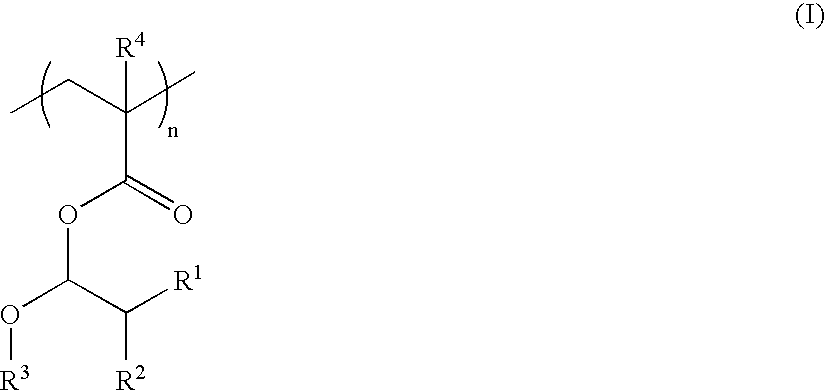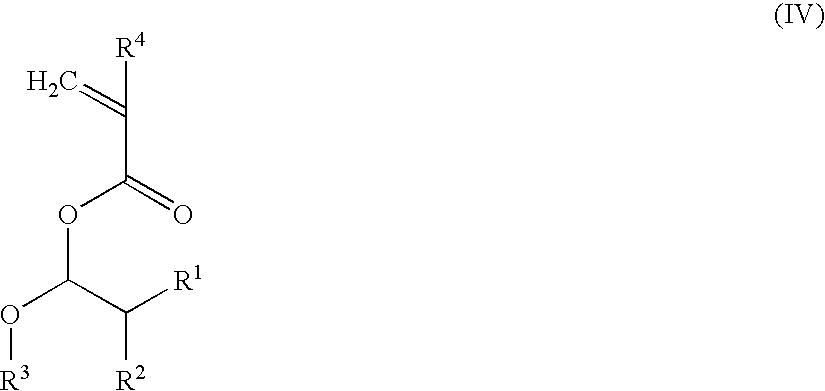Composition sensitive to visible light
- Summary
- Abstract
- Description
- Claims
- Application Information
AI Technical Summary
Benefits of technology
Problems solved by technology
Method used
Image
Examples
reference example 1
Synthesis of Polymer A
[0045] 8.5 g of 1-n-propoxy-2-methylpropyl methacrylate, 25.0 g of methyl methacrylate, and 1.1 g of 2,2′-azobis(2-methylbutyronitrile) (AMBN) were dissolved in 15.0 g of methyl isobutyl ketone. The mixture was added dropwise to 35.0 g of methyl isobutyl ketone heated at 70° C. over 2 hours, and polymerized at 70° C. for 3 hours. Then, 83.0 g of methyl isobutyl ketone was added to the reaction mixture and cooled to the room temperature. The resultant reaction mixture was added to 3 L of methanol dropwise at the room temperature to precipitate a polymer, and then filtered to obtain 20.8 g of the polymer having a number average molecular weight of 16,000.
reference example 2
Synthesis of Polymer B
[0046] 7.3 g of 1-n-methoxy-2-methylpropyl methacrylate, 22.1 g of methyl methacrylate, 4.1 g of 2-hydroxyethyl methacrylate, and 1.1 g of AMBN were dissolved in 15.0 g of propylene glycol monomethyl ether acetate (PMA). The mixture added dropwise to 35.0 g of PMA heated at 70° C. over 2 hours, and The monomers were polymerized at 70° C. for 3 hours, and then 83.0 g of PMA was added to the reaction mixture and cooled to the room temperature. The resultant reaction mixture was added dropwise to 3 L of methanol at the room temperature to precipitate a polymer, and filtered to obtain 21.2 g of the polymer having a number average molecular weight of 13,500.
example 1
Production and Evaluation of Photosensitive Composition
[0047] 100 parts by weight of polymer A synthesized in Reference Example 1 was dissolved in 466 parts by weight of cyclohexanone, and to 1 part by weight of 4,4-difluoro-1,3,5,7,8-pentamethyl-4-bora-3a,4a-diaza-s-indacene and 5 parts by weight of NAI-105 (a photo-acid-generating agent, available from Midori Kagaku Kogyo Co., Ltd.) were added thereto to prepare a photosensitive composition. The photosensitive composition was applied onto an aluminum plate, which had been subjected to grinding and anodizing treatment, using a spin coating method, and prebaked at 100° C. for 10 minutes, to obtain a photosensitive layer having a thickness of about 1 μm. A step tablet was adhered to the obtained photosensitive layer, and the obtained layer was irradiated with an argon ion laser (Spectraphysic Stabilite 2016) having an intensity of 2.0 mJ / cm2 second, heated at 120° C. for 10 minutes, and developed for 1 minute by using a mixture of a...
PUM
| Property | Measurement | Unit |
|---|---|---|
| Percent by mass | aaaaa | aaaaa |
| Percent by mass | aaaaa | aaaaa |
| Percent by mass | aaaaa | aaaaa |
Abstract
Description
Claims
Application Information
 Login to View More
Login to View More - R&D
- Intellectual Property
- Life Sciences
- Materials
- Tech Scout
- Unparalleled Data Quality
- Higher Quality Content
- 60% Fewer Hallucinations
Browse by: Latest US Patents, China's latest patents, Technical Efficacy Thesaurus, Application Domain, Technology Topic, Popular Technical Reports.
© 2025 PatSnap. All rights reserved.Legal|Privacy policy|Modern Slavery Act Transparency Statement|Sitemap|About US| Contact US: help@patsnap.com



